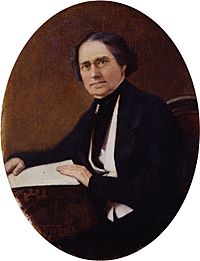Dionysius Lardner facts for kids
Quick facts for kids
Dionysius Lardner
|
|
|---|---|

Dionysius Lardner
|
|
| Born | 3 April 1793 Dublin, Ireland
|
| Died | 29 April 1859 (aged 66) |
| Alma mater | Trinity College, Dublin |
| Known for | Cabinet Cyclopedia |
Dionysius Lardner (born April 3, 1793 – died April 29, 1859) was an Irish writer who made science and technology easy to understand. He was famous for editing a huge collection of books called the Cabinet Cyclopædia, which had 133 volumes.
Contents
Early Life in Dublin
Dionysius Lardner was born in Dublin, Ireland, on April 3, 1793. His father was a lawyer and wanted Dionysius to become one too. However, Dionysius didn't enjoy working in a law office.
In 1812, he decided to study at Trinity College, Dublin. He was a very good student and won many awards. He earned his first degree in 1817 and a master's degree in 1819. While in Dublin, Lardner started writing and giving talks about science and math. He also wrote articles for the Irish Academy.
Career in London
In 1828, Lardner became a professor at University College, London. He taught about natural philosophy (which included physics) and astronomy. He held this job until 1831.
Making Science Popular
Lardner was very good at explaining science to everyone. He gave talks on new ideas, like Babbage's Difference Engine (an early computer). He wrote many books about math and physics. These books covered topics like algebraic geometry, calculus, and the steam engine.
His most famous project was editing Lardner's Cabinet Cyclopædia. This was a massive collection of 133 books published between 1830 and 1844. Many smart people of that time wrote for it. For example, Sir Walter Scott wrote about Scottish history. Thomas Moore wrote about Irish history. Even famous scientists contributed. Lardner himself wrote books in the series about arithmetic, geometry, heat, and electricity.
He also worked on other large projects. These included the Cabinet Library and the Museum of Science and Art. He published some of his own research papers in scientific journals.
Disagreements with Brunel
Dionysius Lardner had some public arguments with a famous engineer named Isambard Kingdom Brunel. Lardner often made mistakes in his calculations, and Brunel would prove him wrong.
The Box Tunnel Debate
In 1833, there was a discussion about building the Great Western Railway. Lardner criticized Brunel's design for the Box Tunnel. He said that if a train's brakes failed in the tunnel, it would go over 120 miles per hour. He thought the train would break apart and hurt passengers.
Brunel explained that Lardner forgot to include air resistance and friction in his math. These are important factors that slow a train down.
Transatlantic Travel Debate
In 1836, Brunel planned to build the SS Great Western. This ship would travel 3,500 miles across the Atlantic Ocean to New York. Lardner said this was impossible. He claimed that a steamship could only travel about 2,080 miles before needing more coal. He even joked that it was like trying to sail to the moon.
Brunel showed that Lardner's math was too simple. Brunel understood that bigger ships could carry more fuel. This made them more efficient for long journeys. The Great Western proved Brunel right. It arrived in New York with plenty of coal left.
Railway Speed Experiments
In 1838, Lardner did some tests on a train called the North Star. This train was on Brunel's broad-gauge railway. Lardner claimed the train used too much fuel at higher speeds. He blamed this on the wider design of the broad-gauge engines.
Brunel and his assistant, Daniel Gooch, did their own tests. They found that the problem was a small part called the blast pipe. Once they fixed it, the North Star's performance improved a lot. Brunel then easily showed that Lardner's findings were wrong.
His Impact on His Time
Lardner was respected as an economist. He was mentioned in Karl Marx's famous book Das Kapital. He also spent time with many important people of his era.
He helped start the University of London. He was the first person to be a professor of natural philosophy and astronomy there. He also helped make Charles Babbage's Difference Engine well-known.
While giving talks in America, Lardner was asked to investigate a train accident. A boiler had exploded on a new train. Lardner said lightning caused the accident. This meant the train builders were not at fault. However, other experts later found that the train's pumps and water indicator were faulty. They also noted that some parts were made of weak cast iron instead of stronger wrought iron.
Selected Publications
Dionysius Lardner wrote and edited many books during his career. Here are a few examples:
- (1828) Popular Lectures on the Steam Engine
- (1830) Mechanics
- (1832) Treatise on Hydrostatics and Pneumatics
- (1840) The Steam Engine Explained and Illustrated
- (1850) Railway Economy
- (1857) Natural Philosophy for Schools

